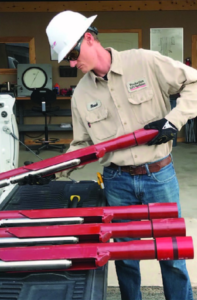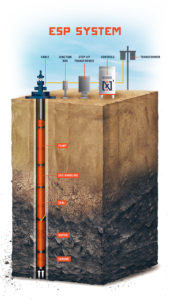The iconic pump jack, emblazoned on hats, jackets, signs, and the hearts of oil and gas people everywhere, is alive and well. No one thinks it’s going anywhere any time soon, because it does still have much work to do.
But underneath the surface, some cracks are appearing in its once ubiquitous and seamless armor. Some of that change involves economic turmoil, but at least an equal part is attributable to a changing of the guard to engineers looking for systems that may be more efficient and more reliable.
“I think what’s starting to happen,” said Mike Swihart, president and CEO of Midland-based Production Lift Companies, “is that we’ve got a younger breed coming through, coming in from different areas, and I think they’re more open and receptive to all the other choices that are out there, instead of just rodding everything up like the old guard did.”
He acknowledged that when a production engineer gets a directive from the company’s president or from accounting demanding a reduction in lease operating expenses (LOE) during the price downturn, that also might prompt an engineer to look at less costly/more efficient lift systems. A warning like, “Either LOE’s going down or you’re going out,” might prompt a look at alternatives.
As a longtime purveyor of alternatives such as plunger lift, gas lift, and more recently, jet pumps and gas-assisted plunger lift (GAPL), Swihart is excited about these new ways of thinking.
Previous downturns have created similar bursts of interest in these alternatives. “We’re counter-cyclical. When the economy goes down, all of a sudden everybody wants to focus on economics, and that’s what we’re about. So we’re a little bit more popular today than we were a year ago.”
Before that time frame, the main extraction focus centered on volume, which emphasized starting wells on ESPs and pumpjacks, regardless of the cost. Today more production engineers are saying, “’Volume is good, but, boy we really have to watch our costs now,’” Swihart said, reciting the sentiments he hears in the field.
Another push toward economizing existing wells comes from the fact that drilling new ones is not economically viable at $40 per barrel and under. “When the drilling programs are up and running, they consume a lot of your field operations people’s time,” he said. Under such conditions, operations people tend to neglect older wells. “But then when drilling slows down and you’ve still got these field people here, I think it’s just a normal human reaction to say, ‘We’d better do something with our time. So let’s make sure we’re getting everything we can out of what we do have.’” This mindset shifts focus to the use of gas lift or other means to economize existing wells.
Surprisingly, Swihart encounters a number of petroleum engineers with years of experience who have never used plunger lift or gas lift and are therefore lacking knowledge about how their workings and advantages.
Unconventional wells, with their massive loads of frac sand, can do more damage to pumps than to gas or plunger lift. Longer bores also lead to more deviations, which can create issues for long rod strings, as well as for electric submersible pumps (ESPs) that can have lengths approaching 200 feet.
Gas lift and plunger-assisted gas lift (PAGL) are in their sweet spot as production begins to drop below the level in which ESPs can operate efficiently, Swihart said. The PAGL makes even gas lift more cost-efficient by reducing the amount of gas injection required.
But he also notes that gas lift is not necessarily limited to the low end of the production cycle. “You can move 20-30,000 barrels a day with gas lift if you set it up right. It can be a high-volume choice.”
With sufficient bottom-hole pressure, Swihart explained, gas lift can be installed upon completion instead of waiting. “If you’ve got the pressure, we can supplement by injecting some additional gas to make this thing aerate and flow out the top.”
Keeping gas lift compressors running has historically been the downside—reliability has been an issue. Swihart sees the growing movement toward electric compression as a solution. Some electric compressors have reached 99 percent runtime, which he said could answer the second main objection to the process (after “we’ve never done it before”).
As might be expected, there are varying opinions of how best to produce wells in the new climate. Stan Logie, president of Logie Gas Lift Consulting, also sees changes in the marketplace but has a different take on the best strategies. “The biggest trends and most important developments would be companies adopting a more holistic approach to cost-efficiently producing wells to their optimum potential, and to the end of producing life,” Logie said.
In his view, more companies are focusing on continuous surveillance systems, including temperature-pressure surveys in gas lift fields and getting trained personnel to use that data to make adjustments that “consistently produce wells to their full potential.” Evaluating wells with nodal analysis allows producers to tailor the systems to each well’s situation.
Logie said operators ask questions about existing methods, such as, “What is the annual predicted failure rate of a high capital expense ESP costing say $250,000? If each failure is catastrophic, costing around $150,000, and is occurring more than once per year, then other artificial lift options may need to be considered.
“For high watercut, low gas-liquid ratio, low production decline rate wells, for example in Reeves County, ESP applications are ideal. Adaptation comes in the form of designing and keeping these wells on ESP for as long as possible, to produce to their lowest economic rates. Failure rate remains the overriding usage factor.”
Overall, however, Logie sees intermittent gas lift among the more versatile options.
“Intermittent gas lift installation is a growing application. IHS Markit, a leading oil industry database company, shows there are 4,625 low producing gas lift wells in the Delaware and Midland Basins with potential application for this type lift.
“Intermittent gas lift remains the premiere means to cost efficiently lift low volume gas lift wells,” he continued. “It is flexible, adapting to various production rate changes, and it offers more direct control to gas injection cycles. Liquid slugs are intermittently propelled by gas expansion at depth, and there is no waiting time needed to build pressure and create pressure differential as with natural plunger lift. Wells most applicable for plunger lift are those with sufficiently high gas liquid ratios around 5,000 scf/stb.”
While all producers are squeezed for profits, Logie finds that certain types of companies are ahead of the technology curve on updating their lift choices. “Leading the way are, from my experience, the mid-sized and mom-and-pop companies, who are attracted to the simplicity and inexpensive traits of IGL. Majors appear slow moving to changes. Many successes and case studies have been realized with smaller operators who are more economically sensitized to changes in lift systems.”
Even so, Logie finds that not all new technologies are able to deliver better results. “There are some new lift technologies out there based on the old. However, many of these techniques are unproven, deploy complex methods of operation, and do not function fully as expected.”
Extract Companies, LLC, is based in Tulsa, with a significant presence in the Permian—offices located just north of the intersection of SH 1919 and FM 1788. Like the others, they’ve seen turmoil in the marketplace creating opportunities for those with new technologies.
Company President Matt Gipson saw producers shift from ESPs to gas lift upon completing wells in the last downturn, of 2014-16. This time is different.
“We’re actually seeing more ESP installations and clients that are more interested in those early production rates and generating cash flows early in the life of the well,” he said. These moves affect NPV (Net Present Value) and IRR (Internal Rate of Return).
With unconventional wells notorious for their steep decline curves anyway, producers needing cash are wanting as much of that production and cash up front, to cover the well’s initial costs. At the same time, Gipson observed, they are concerned about improving ESP performance and reliability, as well as reducing the costs of later interventions such as repairs/replacements. All this is geared to improving cash flow from the expense side.
Cost issues were already brewing before the COVID-19 shutdowns. Gipson believes many customers were in hedge positions in 2020, meaning they needed to produce as much oil as possible while the higher prices were in force. As ESPs typically produce much more oil than does gas lift at the beginning, ESP has been the lift of choice. Producers know they will likely have to change lift systems when production drops below an ESP’s bottom range, but boosting early cash flow is worth it now.
Gipson sees yet another impetus for change beyond viruses. The conversion from vertical wells to horizontal has directly created the need for changes in lift technology. With all that in the works, Extract has recently released a completely redesigned ESP to the market. The new product is called SpeedFreq™.
Said Gipson, “Horizontal well drilling and horizontal completion advancement really outpaced the available artificial lift technology to adequately produce those wells.” This trend started with the shale revolution around 2010. Traditional designs for gas lift, ESP, and other systems created application challenges because of narrower wellbores, 90 degree turns in horizontal wells, and the slight deviations in deeper wells.
“When we were forming Extract, we started thinking about what did the market really need,” he recalled. The top issues they decided to address included high early-stage fluid volumes, steep decline curves over time, high GOR (gas-to-oil ratios), abrasive solids such as frac sand, and small wellbore diameters compared to wellbores in conventional wells.
“That was pushing the envelope of conventional ESP equipment, so we felt there was a need to develop something that would be more suited for that application.”
Specifically in the Delaware Basin, Gipson and his development team saw typical ESPs extending up to 200’ long with 3.75” outside diameter motors. “You have a very long tool. There’s significant opportunity for reliability issues with that, and field service errors.”
So the development process that led to the creation of SpeedFreq, first released in spring 2020, led them to permanent magnet-based motors—something they saw the market moving toward already. “With the permanent magnet motors you get a smaller system because of the high power density of the motor. We’re able to do a lot more horsepower in a lot shorter package,” Gipson explained.
The SpeedFreq comes in at about 45’ instead of the typical 150-200’ of conventional ESPs. Developers also made improvements in gas handling, operating range (the system is designed to be functional down to 500 bbl/day). They added more sensors in order to further improve production and lengthen pump life. Power savings are estimated at 35 percent.
Hard economic times connected with technology advances are still meeting some resistance from the change-resistant among the oil field. Swihart, Logie, and Gipson all have new systems or at least new ways of installing systems that they say can improve efficiencies throughout the production cycle—hoping they can help break down the resistance to change that, if left alone, can lead to extinction.
Paul Wiseman is a freelance writer in the oil and gas industry.













